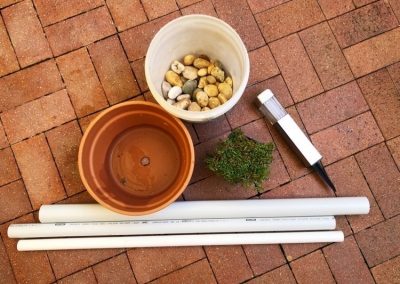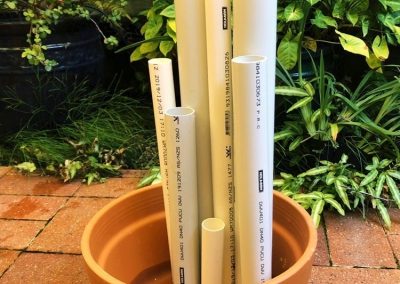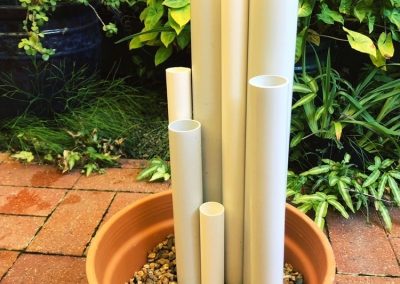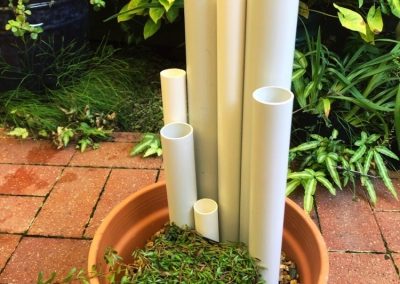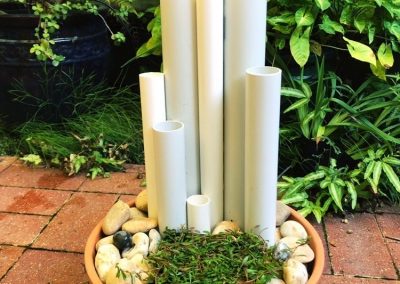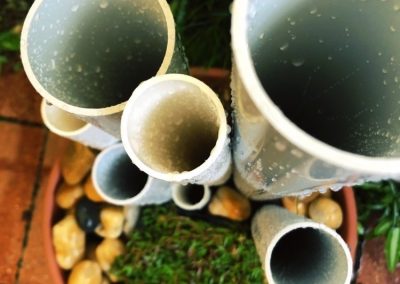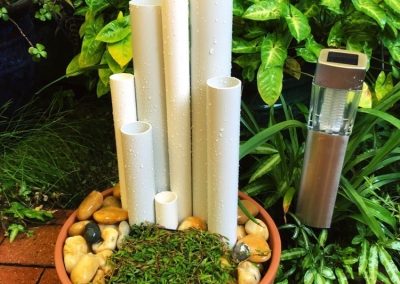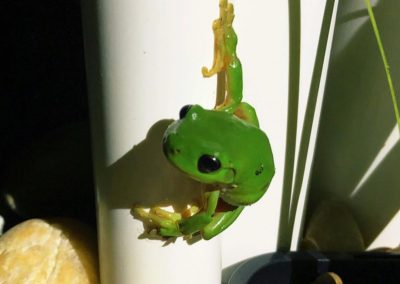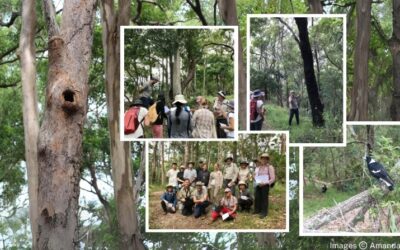24 April 2020 | By Amanda Little
There are 132 frog species listed as occurring in Queensland ‒ more than any other Australian state! However, frog habitat is declining due to the pressures of urbanisation and land clearing (among others)[i]; and more than 30 Queensland frog species are currently listed as endangered or vulnerable to extinction.
Frogs need our help!
Provide a supplementary habitat for frogs in your backyard by building a frog hotel
Frog hotels are a great way to encourage more frogs to visit your garden while giving them a safe space to live in.
What’s more, building a frog hotel is easy and fun and you’ll be rewarded with a croaky chorus of little guests in no time!
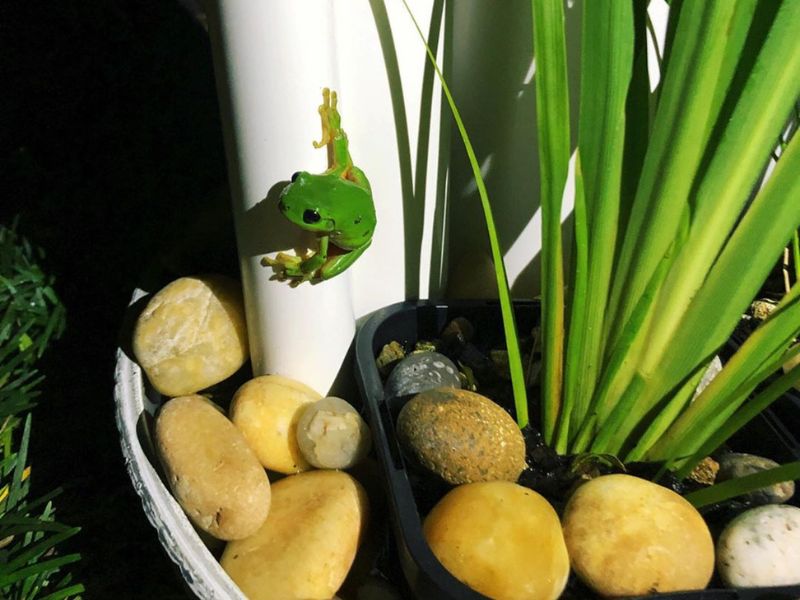
Zoo intern and wildlife rehabilitation volunteer, Ashleigh Miller, who recently built two frog hotels in her garden, says it was a rewarding and relatively inexpensive exercise.
“My frog hotel cost approximately $35 for the PVC pipe, bowl, and plants for one hotel (I already had the gravel, stones, and solar light). It can be even cheaper if you are able to use more recycled materials from home,” says Ashleigh.
Which frogs will check out (and check in to) a frog hotel?
Frog hotels are designed for tree frogs (Litoria species) that can easily climb up the pipes, Ashleigh explains.
“The most common species you might see visiting your frog hotel in Queensland would be Green Tree Frogs (Litoria caerulea), Eastern Dwarf Tree Frogs (Litoria fallax), Bleating Tree Frogs (Litoria dentata) and Desert Tree Frogs (Litoria rubella).”
Have a look at the gorgeous little visitor who checked in to Ashleigh’s frog hotel this week (pictured above).
“We haven’t seen a Green Tree Frog at home for years (we usually get Eastern Dwarf Tree Frogs and other small species), so we were thrilled to spot this little guy.”
Read the ‘Step-by-step guide to building a frog hotel’ below. You can also download the PDF guide here.
Step-by-step guide to building a frog hotel
(by Ashleigh Miller and Allison Begnell)
Materials:
- PVC pipes in 3-4 different widths
- Bowl or tub that will hold water (if your chosen pot/tub has a drainage hole at the bottom, seal this with silicone)
- Small gravel or pebbles
Note:
If you are concerned about snakes, you can cut a hole in the side of the pipes. You could also purchase 3-way PVC pipe connectors at Bunnings or similar, then cut your original PVC pipes in half and attach together with the connector that has the third hole out.
Optional:
- Native water plants
- Large river stones or decorative rocks
- Solar light
Step 1. Cut your PVC pipes to random different lengths and sand back the cut edges so they are smooth.
Step 2. Arrange the pipes how you would like them to look in your chosen bowl or tub.
Step 3. Have an assistant hold the pipes in place while you scoop in the small pebbles/gravel around them until they stand upright on their own. Some additional gravel can be put inside each pipe for extra support.
Step 4. If you are adding a water plant, place it now so that the rim of the pot sits just below the edge of the outer bowl.
Step 5. Fill the rest of the bowl with gravel, decorative rocks or river stones if you would like.
Step 6. Fill the pipes and bowl with water. Your frog hotel is now ready for guests to check in!
Other tips:
- You can also add a solar light in or next to the frog hotel to attract moths and other insects at night for the frogs to feed on.
- If cane toads are common in your garden, you can prevent them from accessing your frog hotel by placing it at least 60 cm off the ground. Frog hotels are designed for tree frogs which will have no trouble climbing up high to get to them.
- Check your hotel every few days and top up with water when necessary. It is best to use water that is chlorine and chemical-free. You can achieve this by purchasing a bottle of water conditioner from the fish section at your local pet store or standing a bucket of tap water outdoors for a minimum of 24 hours.
- Filling with water just up to where the rocks/pebbles will help to avoid too much mosquito activity,
- To prevent water from smelling (also helps with mosquitoes), flush out with a bucket of dechlorinated water every 3-4 days to freshen up the water.
- If you are using plants, make sure you choose ones that are happy to be in constantly wet soil. Some frog-friendly natives include:
- common rush (Juncus usitatus)
- bog primrose (Villarsia exaltata)
- native violet (Viola hederacea)
- frosmouth (Philydrum lanuginosum)
Check your local nursery’s water plant section for more ideas.
More information
For more information on what you can do to help conserve frog habitats:
- Queensland frogs
- FrogID: The Australian Museum’s FrogID helps you identify and record frog calls
- iNaturalist: Become a citizen scientist, record your nature observations and share with other naturalists
[i] see Queensland frogs
Frog hotel build images
All images © Ashleigh Miller
More Wildlife Blogs
5 fascinating facts about Australia’s iconic eucalypts
Eucalypts, those quintessentially Aussie trees, are a true-blue symbol of our land. With approximately 900 species of eucalypt on the planet, almost all of which are native to Australia, it’s no wonder they have their own national day on 23 March!
Who’s visiting your backyard? Identifying wildlife from their scat
Whether you’re in your backyard, exploring a park, or hiking through the bush, do you ever wonder what wildlife species are nearby? Even when wildlife isn’t readily visible, they often leave subtle traces of their presence. One such clue that nature leaves behind is scat, the faeces of animals.
Connecting people and planet on World Wildlife Day
On Sunday 3 March 2024, join us in celebrating Queensland’s incredible biodiversity and taking action to protect it. From wildlife conservation events to community clean-up efforts, there are plenty of opportunities to get involved and make a difference.

